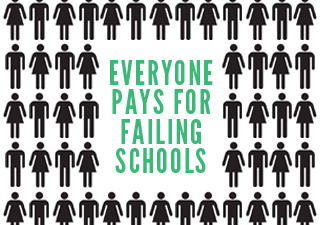Media
Charter Expansion Would Boost Student Learning
 Priya wrote about the recent decline in state test scores and in the number of schools making Adequate Yearly Progress (AYP), noting seven facts union bosses don’t want you to know.
Priya wrote about the recent decline in state test scores and in the number of schools making Adequate Yearly Progress (AYP), noting seven facts union bosses don’t want you to know.
Here is another: In Pennsylvania’s largest cities, charter schools outperformed traditional schools.
In many of the largest, worst-performing districts, charter schools were more likely than district-run schools to make AYP in 2012. In Philadelphia, 13 percent of district schools made AYP, compared with 53 percent of charter schools. In Pittsburgh, 11 percent of district schools made AYP, compared with 39 percent of charter schools in Allegheny County.
| Percentage of Schools Making AYP, 2011-12 | |||
| No. That Made AYP | No. That Missed AYP | Percent | |
| Philadelphia District | 33 | 217 | 13% |
| Philadelphia Charter | 43 | 38 | 53% |
| Pittsburgh District | 6 | 50 | 11% |
| Allegheny Co. Charter | 7 | 11 | 39% |
| Allentown District | 2 | 18 | 10% |
| Lehigh Co. Charter | 2 | 2 | 50% |
| Harrisburg District | 1 | 10 | 9% |
| Dauphin Co. Charter | 1 | 1 | 50% |
| Erie District | 1 | 20 | 5% |
| Erie Charter | 1 | 4 | 20% |
| Reading District | 0 | 24 | 0% |
| Berks Co. Charter | 0 | 1 | 0% |
| Scranton District | 2 | 15 | 12% |
| Lackawanna Co. Charter | 1 | 0 | 100% |
Lawmakers have a chance to expand public school options this fall. Legislation pending before the General Assembly would reform the state charter school law, including:
- Creating a statewide board that can authorize new charter schools. Currently, only school districts can approve new brick-and-mortar charter schools (the state handles cyber charters), effectively limiting the options for parents. This is like giving McDonald’s sole authority to approve new Wendy’s locations.
- Increasing ethics rules and accountability measures for charter school operators.
- Providing funding for charter schools directly from the state, rather than through school districts.
- Providing a “parent trigger” whereby parents could convert a failing district school to a charter school. Such measures make schools directly accountable to parents for providing children a quality education. Current legislation would allow this only when 50 percent of parents and 50 percent of teachers support such a conversion. Strengthening such language to allow a group of parents to perform such a turnaround alone would create a meaningful parent trigger.
For more, read our recent Policy Points on the parent trigger, and our policy memo covering PSSA results and charter schools.